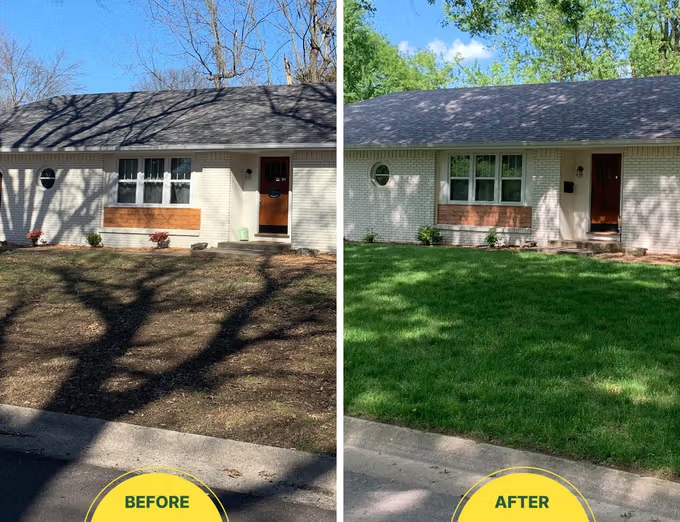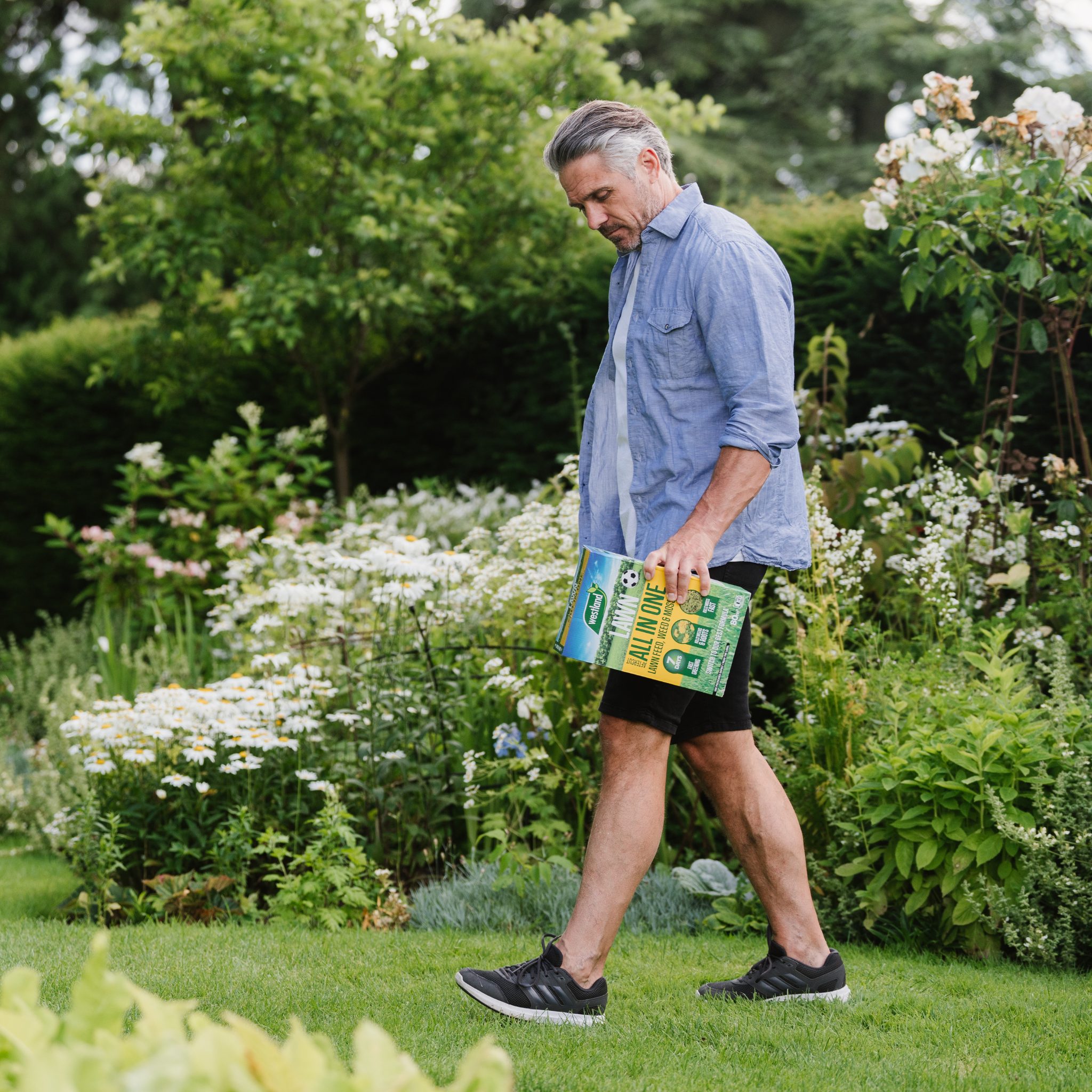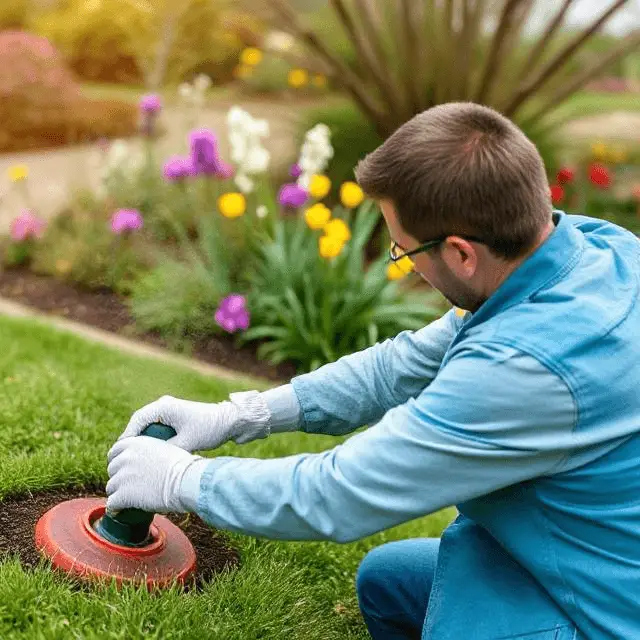What Is the Best Way to Seed Grass in Spring?
Last Updated on April 23, 2025 by Duncan
Overseeding is a spring process that involves sowing new grass seed into an existing lawn while carefully not breaking or damaging the turf. This is a fantastic way to fill in barren spots during the winter and improve lawn density and color for the new growing season.
While this is the case, you should note that spring is not the best season to overseed all types of turfgrasses. Continue reading to learn whether it is a good option for your lawn, how to perform it successfully, and how to cope with weeds when overseeding in the spring.
What is overseeding?
Overseeding is spreading grass seeds in an existing lawn without tearing or injuring the old grass or turning the soil. It is a terrific way to rejuvenate a dirty, worn-out lawn and an easy and economical method to:
- Fill in bare or thin spots.
- Make the turf denser.
- Enhance the lawn’s color and attractiveness.
- Add more resilient grass species to your lawn
- Enhance pest, disease, traffic, and drought resistance.
When is the best time to seed your lawn?
The best seasons to overseed warm-season grasses are late spring and early summer. They thrive in warm regions with hot summers and moderate winters, making them the greatest grass choice for homeowners in the southern states and the transition zone.
Warm-season grasses germinate and grow roots best when soil temperatures reach 65 to 75 degrees Fahrenheit; by then, air temperatures are consistently in the 80s.
Here are the most popular warm-season grasses:
- Bahiagrass
- Bermudagrass
- Buffalograss
- Centipedegrass
- St. Augustine grass.
- Zoysiagrass
In the northern parts of the United States, late summer to early October is the best time to overseed cool-season grass. Cool-season grasses can tolerate harsh winters and thrive in temperate summers.
In the fall, the soil is warm enough for cool-season grass seeds to germinate well, and cooler nights protect the new grass from heat stress.
Spring is the second best time to overseed cool-season grasses in your lawn. If you didn’t overseed your property in the fall, you can still do so in early spring when soil temperatures range from 50 to 65 degrees Fahrenheit.
You’ll need to keep a strict schedule so fresh seedlings have plenty of time to germinate and establish themselves before the summer heat arrives.
Here are the most popular cool-season grasses:
- Fine fescues.
- Kentucky bluegrass
- Perennial ryegrass.
- Tall fescue
What is the best way to seed grass in spring?
Fix any existing lawn problems.
There is a reason why your grass is thinned out in the spring, leaving bare or brown spots. It could be simple underwatering, a pH imbalance, overfertilization, or soil compaction. However, it could also be a fungal infection or harmful pests such as grubs or chinch bugs.
Before overseeding this spring, do your utmost to identify and remedy the problem. This ensures your lawn grows thick and lush while preventing newly planted grass from becoming yellowish.
Check the soil’s pH and fertility. Acidic soils can be modified with lime, whereas alkaline soils require treatment with elemental sulfur. The soil test findings also indicate which nutrients are deficient or abundant in your lawn, allowing you to apply the appropriate lawn fertilizer while overseeding.
Mow the grass low
Before overseeding your lawn, mow it to a height of 1 ½ to 2 inches. However, avoid scalping the turf.
You should note that a neatly groomed lawn:
- Helps more seeds get through the grass leaves and into the soil.
- Exposes the soil to more sunshine, warming it and promoting germination, allowing grass seeds to develop more quickly.
After mowing, rake the lawn and collect the grass clippings. This eliminates dry or dead grass, twigs, leaves, and trash.
Mow the entire lawn as needed to keep the height around 3 inches. Mow with a sharp blade while the grass is dry. Avoid taking forceful turns in recently sown areas. Mowing straight lines across top-dressed areas will cause minimum disturbance to grass seedlings.
Don’t allow the grass to grow too tall between mowings. Routine mowing promotes root growth in seedlings.
Dethatch and aerate the lawn
If your soil is compacted, aerate it as part of your spring lawn care regimen. Aeration loosens the soil, allowing grass roots to grow more freely. It also enhances ventilation, allowing water and nutrients to trickle deeper into the earth and nourish the grassroots.
Dethatching removes a layer of dead organic matter (dead grass, roots, and leaves) that creates a dense mat on top of the soil. Thick thatch keeps grass seeds from reaching the ground and must be cleaned before overseeding.
Aeration eliminates some thatch, but not all. Whether you aerate or not, you must dethatch or power rake the lawn.
Use a dethatcher or a scarifier to remove the thatch.
When dethatchers are set to the lowest setting, their spring tines delicately rough up the topsoil. They break up thin to fairly thick thatch layers and gently remove dirt.
Scarifiers use metal blades to cut deeper into the soil, breaking up thicker thatch levels with less effort.
Finally, rake the organic material off your grass. Raking also loosens the soil surface, making it more straightforward for grass seeds to root.
Choose the right grass seed for your lawn.
Keep the same grass seed mix or upgrade your lawn: If you’re satisfied with your turf, look for and apply the same grass mix already growing in it.
The other alternative is to use spring overseeding and replace your lawn with more durable grass types. For example, with shade-tolerant cultivars such as tall and fine fescues, you can overseed shaded sections of a ryegrass lawn (ryegrass requires full sun to thrive).
Select only grasses appropriate for your location: To guarantee a healthy, low-maintenance lawn, seed a turf type suitable for your environment.
Cool-season grass seed varieties are most suited to the northern, eastern, and western regions of the United States. Warm-season grass varieties thrive in the southern, southeastern, and southwestern areas.
Consider the timing: Perennial ryegrass germinates in 5–10 days. Because of its rapid germination, it is an ideal grass for spring sowing, when young plants have just a short window to grow robust enough for summer.
Kentucky bluegrass takes a lot longer to sprout. It takes 14 to 30 days before it begins to grow. Few new sprinklings will withstand the summer heat if you do your spring overseeding too late, and you will have to do it again in the fall.
Pro tip: Seek out premium grass seed with a germination rate of at least 75%.
Apply the right amount of grass seed.
When new grass seed emerges, overcrowding may result from applying too much seed. Although the more robust grass sprouts will endure, they might suffocate the current grass, necessitating more overseeding.
To find out how much grass seed you need, measure the lawn or the area that will be overseeded. For instance, you would measure as follows if you were overseeding a thinned area in the driest section of your yard:
To define a rectangle, drive a few pegs into the ground around the area you intend to oversee.
Using a measuring tape, determine the rectangle’s length and width. Assume that the patch is 40 feet by 100 feet.
You can calculate the size of the region you oversee by multiplying the length by the breadth.
Divide larger or more complicated areas, such as your whole yard, into multiple rectangles. Measure the area of each rectangle using the techniques outlined above and sum the numbers.
Next, determine the seeding rate, which is the amount of seed per 1,000 square feet. It’s helpful to know what product you’re purchasing at this stage. If not specified on the seed packaging, follow these general guidelines:
If most of your lawn is covered in dense grass, overseeding will be a routine maintenance. Use 2 to 4 pounds of seed for every 1,000 square feet of lawn.
Use 4 to 8 pounds of seed per 1,000 square feet if your lawn has barren spots.
For lawns that need to be completely renovated, 8 to 12 pounds of new grass seed per 1,000 square feet of turf are necessary.
To determine the required amount of seed, divide the total measured area by 1,000 and multiply by the seeding rate. For our example of 4,000 square feet and a seeding rate of 6 pounds per 1,000 square feet, you’d compute as follows:
4,000 square feet / 1000 square feet multiplied by 6 pounds equals 24 pounds.
Properly spread the grass seed.
You are ready to overseed your lawn. To begin your DIY overseeding, you must first select the appropriate tool for your grass.
You can use a handheld seeder on tiny patches.
Drop seed spreaders are common options for small to medium-sized lawns. They release grass seeds directly beneath, ensuring superb precision.
Broadcast spreaders are more efficient for larger lawns. They scatter the seeds broadly, resulting in greater coverage and speed but less precision.
To put grass seed in your yard, follow these procedures.
Fill the seed spreader with grass seed.
Set the seeder to half the spread rate stated on the seed bag.
Spread half of the amount over the area you want overseed, traveling back and forth steadily.
Change your walking direction by 90 degrees and repeat the previous procedure, scattering the remaining half of the turf seeds.
Use the back of a rake to incorporate the seed into the topsoil.
Should you top-dress your grass before or after overseeding? This is a contentious subject. Grass seed requires healthy ground, good soil contact, and a high-quality top treatment applied to the grass. However, grass seed should not be coated with layers thicker than ⅛ to ¼ inch.
You can spread compost or a topdressing mix.
Before overseeding, apply a layer no thicker than ½ inch to avoid injuring established turf.
After overseeding, apply a thinner layer up to ¼ inch deep.
Pro tip: Peat moss is an excellent top dressing that indicates when it’s time to water the seeds by changing color – peat transforms from a dark, nearly black color when wet to a light brown when dry.
Water the seeds until they germinate.
Grass seeds require continual wetness to germinate. Water the planted areas lightly twice daily until the grass germinates (around two to four weeks). Keep the sprinklers on for 10 to 15 minutes at a time. This usually builds up to 3-4 inches of water per week, with 1/8 to 1/4 inch applied each time.
The amount of water required during germination varies depending on the weather, soil type, water pressure, and sprinkler flow rate. Keep the top 1-2 inches of soil moist (but not waterlogged) and seeds from drying out.
Pro tip: If you’re overseeding a lawn with existing grass, water it deeply once a week to help the roots grow.
Once all the seeds have germinated, gradually reduce the frequency and increase the water you use each time. Do this for one to two weeks until you reach your regular irrigation schedule once or twice a week, with 1 to 1.5 inches of water per week.
Water the lawn well every session to hydrate the top 6 to 8 inches of soil and develop strong roots.
Fertilize the grass
New grass also needs additional fertilizers. Apply starter fertilizer before or immediately after overseeding the lawn. Starter fertilizers contain a small amount of phosphorus, which helps grass sprouts develop healthy roots.
Pro tip: When overseeding the lawn, avoid using weed and feed. The herbicide in the mix influences grass germination and growth.
FAQs
How long does it take for new grass seed to fully establish after overseeding?
Grass seed typically sprouts in 7-21 days, but complete coverage requires 6-8 weeks with adequate care. Speed is affected by the weather, the soil, and the type of seed.
Regularly mowing, watering, and fertilizing will help your lawn thicken and stay healthy throughout this early period.
Can you walk on my grass once it’s been overseeded?
Avoid strolling in newly sown areas for the first 3-4 weeks to safeguard seedlings. Foot traffic can harm delicate shoots and compacted soil. If you must walk on it, use boards or stepping stones to relieve strain and avoid damaging fresh grass growth.
What can you do if heavy rain washes away your grass seed?
Allow the area to dry, then softly rake and reseed any bare places. Cover reseeded areas with straw or mulch to keep the seed in place. Water carefully afterward to prevent more washout and to help seeds settle without causing additional soil erosion.


